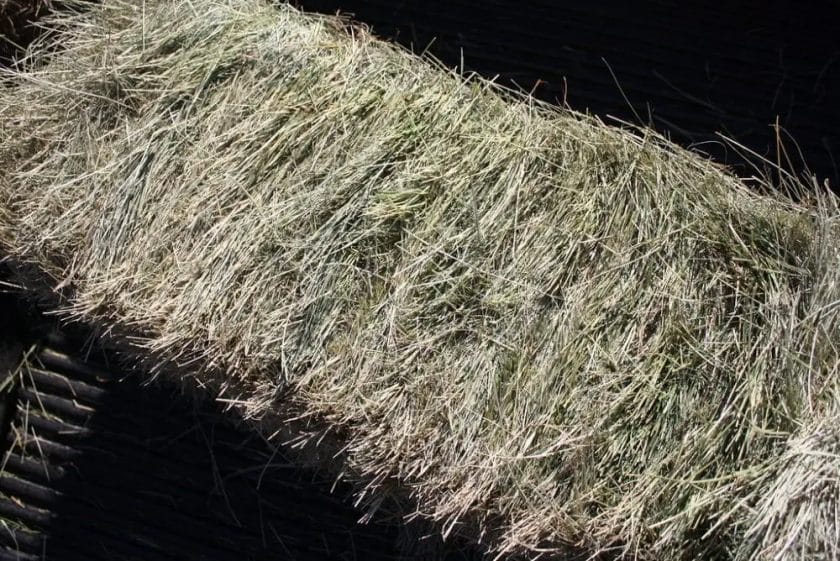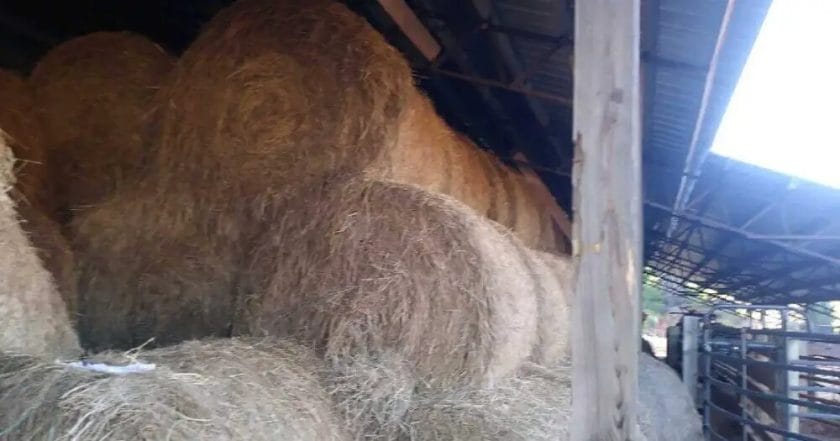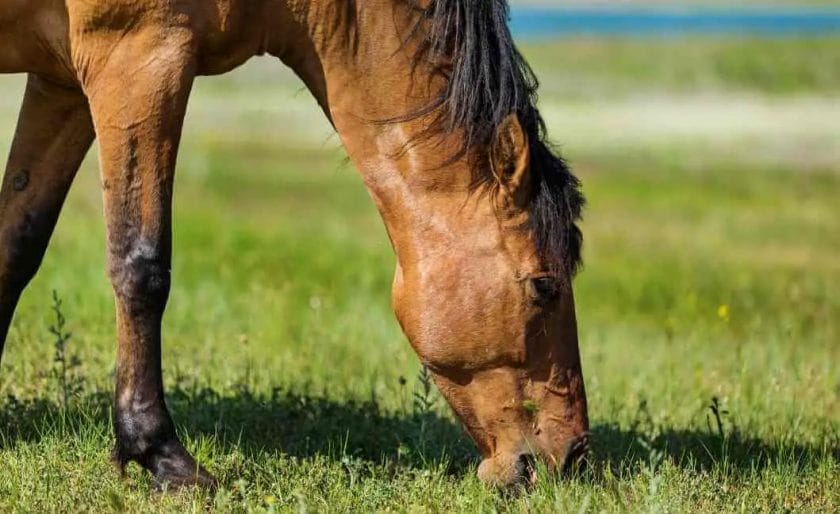Bahia hay is a popular choice for horse owners and enthusiasts due to its numerous benefits. Known for its exceptional nutritional value, Bahia hay is rich in essential nutrients like protein, fiber, and minerals, making it an excellent source of high-quality forage for horses.
Additionally, Bahia hay has a low sugar content, making it suitable for horses with metabolic conditions such as insulin resistance or Equine Metabolic Syndrome (EMS). Its coarse texture promotes healthy digestion and helps prevent colic, making it a safe and reliable choice for equine diets.
Furthermore, Bahia hay is drought-tolerant and resilient, allowing it to thrive in various climates and soil conditions. Its deep root system helps prevent erosion and contributes to soil health, making it an environmentally sustainable option for horse pastures.
In conclusion, Bahia hay is a highly beneficial forage choice for horses due to its nutritional value, low sugar content, digestive health benefits, and environmental sustainability. Horse owners can confidently include Bahia hay in their horses’ diets for optimal health and wellbeing.

Nutritional Value of Bahia Hay for Equine Diet
Bahia hay is a popular choice among horse owners and farmers for feeding horses. It is a type of grass hay that offers several nutritional benefits for equines. Understanding the nutritional value of Bahia hay is essential for ensuring a well-balanced and healthy diet for horses.
Protein Content
Bahia hay typically has a moderate protein content, making it suitable for horses with average protein requirements. The protein content may vary depending on factors such as soil conditions, maturity at harvest, and storage methods. On average, Bahia hay contains around 8-10% protein. Protein is essential for muscle development, tissue repair, and overall growth in horses.
Energy and Fiber
Bahia hay is known for its high-fiber content, which provides horses with a steady source of energy. The fiber in Bahia hay is primarily in the form of cellulose, hemicellulose, and lignin. This fibrous content aids in proper digestion and helps prevent digestive issues such as colic. However, due to its high fiber content, Bahia hay may not be suitable for horses with specific dietary needs, such as those with metabolic disorders.
Vitamins and Minerals
Bahia hay is a good source of vitamins and minerals required for equine health. It contains essential minerals like calcium, phosphorus, magnesium, and potassium, which play a vital role in maintaining strong bones, muscle function, and overall electrolyte balance. Additionally, Bahia hay provides essential vitamins such as vitamin A, vitamin E, and vitamin K, which are necessary for various bodily functions in horses.
Hydration and Water Intake
Bahia hay has a lower moisture content compared to other types of forages, which helps in shelf life and storage. However, it is essential to ensure that horses consuming Bahia hay have access to fresh, clean water at all times. Adequate hydration is crucial for proper digestion, nutrient absorption, and overall equine health.
Feeding Recommendations
When including Bahia hay in a horse’s diet, it is important to consider their individual nutritional requirements, workload, and overall health. Consulting with a veterinarian or equine nutritionist can help determine the appropriate amount of Bahia hay to feed a horse.
It is recommended to provide horses with a combination of quality forages, such as a mix of Bahia hay and other grass hays, to ensure a well-rounded diet. This allows horses to receive a balance of nutrients and prevents any potential deficiencies.
In summary, Bahia hay offers several nutritional benefits for horses and is a popular choice for equine diets. Its moderate protein content, high fiber content, and essential vitamins and minerals make it a suitable forage option for many horses. However, it is important to consider individual horse’s requirements and consult with experts to ensure a balanced diet for optimal equine health.

Best Practices for Growing and Harvesting Bahia Hay for Horses
When it comes to feeding horses, hay is an essential part of their diet. And if you’re a horse owner looking for a nutritious and high-quality option, Bahia hay is a great choice. Bahia grass, a warm-season perennial, is widely known for its excellent grazing and hay production qualities. To ensure that you grow and harvest the best Bahia hay for your horses, here are some best practices to follow:
1. Soil Preparation
Before planting Bahia grass, it is crucial to prepare the soil adequately. Start by conducting a soil test to determine the pH level and nutrient deficiencies. Bahia grass prefers a pH range of 5.5 to 6.5. If adjustments are needed, apply lime or sulfur accordingly. Additionally, incorporate organic matter into the soil to improve its structure and drainage.
2. Seed Selection and Planting
Choosing high-quality Bahia grass seed is vital for a successful harvest. Look for certified seeds that have been tested for purity and germination rates. The recommended planting time for Bahia grass is during late spring or early summer when soil temperatures are consistently above 65°F.
Prepare the seedbed by tilling the soil and removing any weeds or debris. Spread the seeds evenly and not too deep, as Bahia grass requires sunlight for germination. It is advisable to roll or pack the soil after planting to ensure good seed-to-soil contact.
3. Fertilization
Proper fertilization is essential for promoting healthy growth and maximizing hay production. Conduct regular soil tests to determine the specific nutrient requirements of your Bahia grass. Typically, Bahia hay requires nitrogen, phosphorus, and potassium in varying amounts.
Divide the yearly fertilizer application into several smaller doses for better absorption and utilization by the grass. Apply the appropriate fertilizer based on the soil test results and follow the recommended rates for Bahia grass. Avoid over-fertilization, as it can result in excessive vegetative growth and reduced hay quality.
4. Irrigation
Bahia grass has good drought tolerance, but adequate water supply is still necessary for optimal growth and hay production. Monitor the soil moisture levels regularly and water the grass when needed. Deep, infrequent irrigation promotes the development of a deep root system, which helps the grass withstand dry periods more effectively.
5. Weed Control
Maintaining weed-free pastures is crucial for high-quality Bahia hay. Implement an integrated weed management program that includes cultural, mechanical, and chemical control methods. Regular mowing can help suppress weed growth and prevent them from going to seed. Additionally, be cautious when using herbicides near Bahia grass to avoid damaging the crop.
6. Harvesting
Knowing the optimal time to harvest Bahia hay is essential to ensure maximum nutritional value and palatability. The ideal time for cutting is when the grass is in the boot stage, meaning the seed heads are just emerging but still enclosed in the sheath. At this stage, the hay will have the best balance of nutrients.
Mow the grass to a height of 3 to 4 inches to leave some stubble that helps with regrowth. Allow the cut grass to dry in the field until it reaches the desired moisture level for baling, typically around 15-20%. Baling should be done promptly to prevent mold or spoilage.
7. Storage
Proper storage is crucial to preserve the quality of Bahia hay. Store the bales in a well-ventilated and dry area to prevent moisture buildup and the growth of mold. Choose a location away from direct sunlight and off the ground to avoid moisture absorption.
In summary, following these best practices will help you grow and harvest high-quality Bahia hay for your horses. From soil preparation to storage, paying attention to these key steps will ensure that your horses receive the nutritious and palatable forage they need.

How Bahia Hay Affects Horse Digestion and Gut Health
Bahia hay is a popular type of forage that is commonly fed to horses. It is derived from the Bahia grass, a warm-season perennial grass species that is native to South America. The nutritional composition of Bahia hay can have a significant impact on a horse’s digestion and gut health. In this section, we will explore the various ways in which Bahia hay affects horse digestion and why it is important to consider the quality of this forage.
Nutritional Profile of Bahia Hay
Bahia hay is known for its high fiber content, making it a valuable source of roughage for horses. The high fiber content in Bahia hay provides several benefits for digestion and gut health. Fiber plays a crucial role in maintaining proper gut motility and preventing digestive disorders such as colic. Additionally, Bahia hay is low in protein and energy, making it an ideal feed for horses that require a controlled diet.
However, it is important to note that the nutritional profile of Bahia hay can vary depending on factors such as soil conditions, maturity at harvest, and storage methods. These factors can influence the digestibility and nutrient content of the hay, ultimately affecting its impact on horse digestion and gut health.
Digestion and Gut Health Benefits
Bahia hay’s high fiber content promotes efficient digestion in horses. The long strands of fiber in the hay stimulate chewing, which aids in the production of saliva. Saliva contains essential enzymes that initiate the breakdown of carbohydrates in the mouth, facilitating proper digestion in the stomach and small intestine.
The fiber in Bahia hay also acts as a prebiotic, providing nourishment for beneficial gut bacteria. These bacteria play a vital role in maintaining a healthy gut microbiome, which is essential for overall digestive health. A balanced gut microbiome helps improve nutrient absorption, immune function, and can prevent the growth of harmful bacteria in the gut.
Potential Challenges and Considerations
While Bahia hay offers several benefits for horse digestion and gut health, there are some potential challenges and considerations to keep in mind. One of the main concerns is the presence of endophyte-infected grasses. Endophytes are fungi that can produce toxins, causing health issues in horses if ingested. It is essential to ensure that the Bahia hay is free from endophyte infection to safeguard the horse’s health.
Additionally, the maturity at harvest and storage conditions of Bahia hay can impact its nutritional value. Hay that is harvested too late or stored improperly may have lower nutrient content and digestibility. Regular hay testing and quality assessment are vital to ensure that the hay is providing the necessary nutrients and fiber for optimal horse digestion and gut health.
In summary, Bahia hay is a valuable forage option for horses that offers numerous benefits for digestion and gut health. Its high fiber content promotes efficient digestion and supports a healthy gut microbiome. However, it is crucial to consider factors such as nutritional profile, endophyte infection, and hay quality to maximize the benefits of Bahia hay for horses. By providing horses with high-quality Bahia hay, horse owners can contribute to their overall digestive well-being.
5. Tips for Incorporating Bahia Hay into your Horse’s Feeding Routine
When it comes to feeding your horse, hay plays a vital role in their diet. Bahia hay, a type of warm-season grass, is a popular choice for horse owners due to its nutritional benefits and palatability. If you are considering incorporating Bahia hay into your horse’s feeding routine, here are some tips to help you do it effectively:
1. Introduce Bahia hay gradually
When introducing Bahia hay to your horse, it is essential to do it gradually. Horses have sensitive digestive systems, and sudden changes in their diet can lead to digestive upset. Start by mixing small amounts of Bahia hay with their regular hay and gradually increase the proportion over a period of 7-10 days. This will allow their digestive system to adjust to the new hay gradually.
2. Monitor your horse’s intake
Keep a close eye on your horse’s hay intake when incorporating Bahia hay into their feeding routine. Some horses may be picky eaters and may initially show resistance to the new hay. Ensure that your horse is consuming an adequate amount of Bahia hay to meet their nutritional needs. If you notice a decrease in their hay intake, consider consulting with a veterinarian or equine nutritionist for guidance.
3. Consider the nutrient content
One of the reasons why Bahia hay is popular among horse owners is its nutritional profile. However, it is important to consider the nutrient content of Bahia hay in relation to your horse’s specific dietary requirements. The nutrient content can vary depending on factors such as soil conditions and harvesting techniques. Conducting a hay analysis or consulting with an equine nutritionist can help you determine if Bahia hay is suitable for your horse’s specific needs.
4. Provide clean and fresh hay
Regardless of the type of hay you feed your horse, it is crucial to provide clean and fresh hay. Bahia hay should be stored in a clean, dry area to prevent mold or dust contamination. Remove any soiled or moldy hay from the feeding area to maintain the quality of the forage. Horses are more likely to consume hay that is free from contaminants, ensuring that they receive the necessary nutrients from the Bahia hay.
5. Supplement with other forages if necessary
While Bahia hay can provide a significant portion of your horse’s forage needs, it may be necessary to supplement with other forages, such as alfalfa or Timothy hay. This is especially true for horses with high energy requirements or those with specific dietary needs. Consulting with an equine nutritionist can help you determine the appropriate forage combination to meet your horse’s individual needs.
In summary, incorporating Bahia hay into your horse’s feeding routine can provide them with a nutritious and palatable forage option. However, it is crucial to introduce it gradually, monitor their intake, consider the nutrient content, provide clean and fresh hay, and supplement if necessary. By following these tips, you can ensure that your horse receives the benefits of Bahia hay while maintaining their overall health and well-being.
FAQs
Is Bahia Hay good for horses?
Yes, Bahia Hay is generally considered a good option for horses. It is a warm-season grass that is high in fiber and low in protein, making it suitable for most horses’ dietary needs. However, it is important to have it tested for nutritional content to ensure it meets your horse’s specific requirements.
What is the ideal amount of hay to feed a horse?
The ideal amount of hay to feed a horse depends on its weight, age, activity level, and overall health. As a general guideline, a horse should consume 1.5% to 2% of its body weight in hay each day. It is best to consult with a veterinarian or equine nutritionist to determine the precise amount for your horse.
How should hay be stored to maintain its quality?
To maintain the quality of hay, it should be stored in a dry, well-ventilated area away from direct sunlight. It is recommended to store hay off the ground on pallets or racks to prevent moisture absorption. Additionally, hay bales should be protected from rodents and insects to avoid contamination.
Conclusion
In conclusion, Bahia hay can be a good option for feeding horses due to its nutritional value and palatability. The hay is high in protein, low in sugar, and contains essential nutrients that support the overall health and performance of horses. Its coarse texture also promotes proper digestion and helps prevent colic. Additionally, Bahia hay is known for its affordability and availability, making it a practical choice for horse owners. However, it’s important to consider individual horse’s dietary needs and consult with a veterinarian or equine nutritionist before making any significant changes to their feeding regimen. Overall, Bahia hay can be a valuable addition to a horse’s diet when incorporated wisely.
